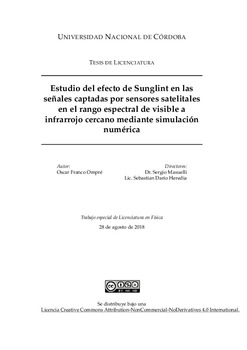| dc.contributor.advisor | Masuelli, Sergio, dir. | |
| dc.contributor.advisor | Heredia, Sebastián Darío, dir. | |
| dc.contributor.author | Ompré, Oscar Franco | |
| dc.date.accessioned | 2018-09-04T13:07:01Z | |
| dc.date.available | 2018-09-04T13:07:01Z | |
| dc.date.issued | 2018-08-28 | |
| dc.identifier.uri | http://hdl.handle.net/11086/6547 | |
| dc.description | Tesis (Lic. en Física)--Universidad Nacional de Córdoba, Facultad de Matemática, Astronomía, Física y Computación, 2018. | es |
| dc.description.abstract | En la actualidad es de suma importancia la obtención de parámetros de ocean color, es decir, datos que nos aportes información sobre el contenido de los océanos y mares como por ejemplo los niveles de fitoplancton que componen un aspecto fundamental en las cadenas de producción pesquera y la forma en la cual evolucionan los ecosistemas dentro de los océanos. Mediante el uso de satélites con sensores a bordo capaces de obtener estas variables es posible llevar a cabo un monitoreo constante, pero en determinadas situaciones es de extrema dificultad la obtención de las variables de ocean color. En este trabajo se estudia y caracteriza el fenómeno de sunglint , es decir la reflexión especular del sol en la superficie del agua de mar, para conocer de que forma se comporta y cuales son los parámetros mas sensibles utilizando un modelo de trasferencia radiativa. La radiación que llega al satélite debido a este efecto termina por cubrir completamente las radiancias que tienen directa relación con los componentes del agua, como el la Water Leaving Radiance(WLR). Si se pudiera caracterizar de forma univoca esta radiación y conocer los parámetros por los cuales esta es producida se podría diseñar una corrección que sumada a la corrección atmosférica permita obtener las variables de ocean color deseadas. | es |
| dc.description.abstract | At present it is very important to obtain parameters of textit ocean color, that
is, data that provide us with information about the content of the oceans and seas, such as the phytoplankton levels that make up a fundamental aspect in the chains of fishing production and the way in which the ecosystems evolve within the oceans. By using satellites with on-board sensors capable of obtaining these variables it is possible to carry out constant monitoring, but in certain situations it is extremely difficult to obtain the ocean color variables. In this work we study and characterize the phenomenon of textit sunglint, that is to say, the specular reflection of the sun on the surface of seawater, in order to know which way it behaves and what are the more sensitive parameters using a radiative transfer model. The radiation that reaches the satellite due to this effect ends up completely covering the radiances that have a direct relation with the water components, such as the Water Leaving Radiance (WLR). If this radiation could be characterized univocally and know the parameters by which it is produced, a correction could be designed that, added to the atmospheric correction, allows to obtain the desired ocean color variables. | en |
| dc.language.iso | spa | es |
| dc.rights | Attribution-NonCommercial-NoDerivatives 4.0 Internacional | * |
| dc.rights.uri | http://creativecommons.org/licenses/by-nc-nd/4.0/ | * |
| dc.subject | Observaciones geofísicas, instrumentación y técnicas | es |
| dc.subject | Geophysical observation, instrumentation techniques | en |
| dc.subject.other | Teledetección | es |
| dc.subject.other | Radiative transfer | en |
| dc.subject.other | 6S | en |
| dc.subject.other | Ocean color | en |
| dc.title | Estudio del efecto de Sunglint en las señales captadas por sensores satelitales en el rango espectral de visible a infrarrojo cercano mediante simulación numérico | es |
| dc.type | bachelorThesis | en |





